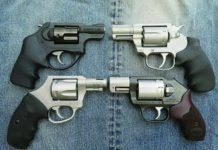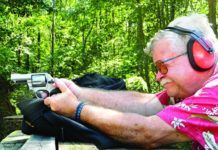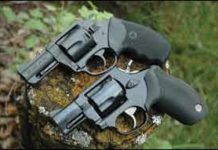A leading firearms trainer from a major metropolitan police force once spent hours on the witness stand being pressed repeatedly regarding the exact amount of shots that would be necessary to end a specific armed confrontation. After whittling away at the defense lawyer’s skewed line of questioning, the subject of cartridge was raised. Finally, the officer spouted his own hard-earned philosophy: “Naturally, I’d rather get hit with a BB than with a salad bowl, but if you train to hit the target repeatedly, until the threat has stopped, then caliber is secondary.”
The wisdom in that testimony is simple to distill: To end threats quickly, officers should be able to shoot the biggest round they can handle—it’s much smarter to hit the other guy with a salad bowl, if you can shoot it with the accuracy of the BB. However, there are few rounds that easily allow for that balance of power and controllability, irrespective of whether the shooter is a policeman or a citizen. One such salad-bowl round that often goes overlooked is the .44 Special, baby brother to the .44 Magnum. There are not many revolvers available today chambered strictly for .44 Special. Most often this cartridge is used in .44 Magnum revolvers as a less volcanic alternative. Still, the Special might have a special niche all its own when it comes to adapting the 0.430-inch-diameter slug to a concealable platform. Compared to the magnum round, it is shorter overall and less powerful, meaning the gun can be constructed with less and of lighter materials.
We recently shot three such concealable .44 Specials: Charter 2000’s $329 reincarnation of the Bulldog; Smith & Wesson’s $722 M396 Mountain Lite, and Taurus’s $483 445ULT, to see which one makes the most sense as a powerful gun to pack on your person.
Matching the guns up, we noted that all three revolvers weigh between 20 and 24 ounces, despite the use of different materials. Both the Charter Bulldog and the Taurus 445ULT fit the standard snub-nosed profile. The Smith & Wesson Mountain Lite resembles the larger-framed Smith & Wesson Model 624 fashioned with the use of titanium. The 396 challenges the limits of concealability because it’s the longest, but it is the lightest of the trio nonetheless. Our aim in this battery of tests was to find out which one we would most likely partner with, whether joined at the hip, purse, briefcase, knapsack or glove box.
Range Session
Simply stated, we learned early that none of these three revolvers are likely to serve any duties outside carry. Even the Mountain Lite, with the longest sight radius of the trio, won’t cut it as a plinker due to its high level of recoil. Also, none of them would be mistaken as target guns. As a result, we chose to limit accuracy testing to 15 yards from a sandbag rest.
Despite being aimed at the concealment market, all three arrived with standard rather than bobbed hammers. With the option of firing single action, we chose this as our primary mode of fire. Another reason for choosing single action for the bench shooting was we judged the double action on two of the three (Taurus excluded) to have substandard double-action triggers. This is magnified when attempting to shoot off of a bench. We reserved our double-action shooting to offhand standing at 12 yards.
Our choice of ammunition was limited because .44 Special is not produced on the same scale as more popular calibers. This also means it can be considerably more expensive, but we didn’t find the cost to be prohibitive. Prices ranged from $14.99 for a box of 50 (factory new) 210-grain lead flat-point rounds from Black Hills to $12.50 per 20-round box of 180-grain Hornady XTP hollowpoints. We also purchased 20-count boxes of Federal Classic 200-grain lead semi-wadcutter hollowpoints for $10.95 and called it a bargain. While the left side of the barrel of the Mountain Lite reads “Max Bullet 200 Grain,” we cheated and shot the 210-grain lead bullets in this gun anyway. Actually, this combination worked very well fired offhand.
Here’s what we found:
Smith & Wesson M396 Mountain Lite
Our recommendation: Conditional Buy. This $722 product is a high-tech gun for the role it is designed to play, hence the cost. Our sample was plagued by a difficult let-off when triggered double action, and we’re not sure Smith & Wesson will fix it. If not, you would have to pay a gunsmith to work on the trigger, which would push the gun’s price toward $800. Still, the gun performs, so you’ll have to decide if you mind spending more for something unique.
The Smith & Wesson M396 Mountain Lite is by profile an L-frame version of the larger Model 624. Smith & Wesson refers to the makeup of this gun as a “composite” of stainless-steel barrel, aluminum frame, and titanium cylinder. Studs within the frame, as evidenced by the gray dots on the left side, are titanium as well. Contrary to standard concealment construction, this model features adjustable sights and a high-mounted front sight. The key to this is in the surname Mountain Light. It is intended to be backpack gun for the trail, not necessarily an on-the-body concealment weapon. For true concealability, refer to the hammerless L-frame Centennial model 296 reviewed in July 1999. We gave the 296 an unconditional Buy rating, and in retrospect we feel it is a heck of a good gun for five-shot revolver fans, despite lukewarm sales.
The 396 offers more sights than the other two guns in this test or those on the 296. The sight radius is the longest of this trio, but at 4.4 inches it is actually abbreviated by the long light-gathering filament in the front sight. Use of a standard blade would likely increase it to nearly 5 inches, in our estimation. Still, we wouldn’t rate it as a better choice for target work because of its stiff recoil, a function of its light weight. To illustrate just how light this gun is, when loaded with its maximum recommended payload of 200-grain cartridges, its gross weight is increased by more than one third, from 20 to 27 ounces.
The painful effect of little mass combined with power is excess recoil, a problem made worse by a glitch in the double-action trigger. Just before let-off, the trigger locks up or freezes. Sometimes we could pull through it, other times the additional pressure we’d apply to bypass it set us up for a painful dose of recoil as our finger followed through. We traced this problem to the rough meshing of the hand to ratchet. As evidenced by burrs on the edges of the ratchets, the hand is having trouble moving to its final position where the hammer is cleared to drop. One shot was so difficult and the result so surprising, we dropped the gun. This unplanned “drop test” nicked the cylinder and dinged the front sight pretty hard, but nothing broke. Props to HiViz by North Pass, Ltd. ([800] 589-4315) for making a rugged plastic filament.
Accuracy from a benchrest measured, on average, 2.1 to 2.3 inches for all five-shot groups fired. This is pretty remarkable because the variation in bullet configuration, if not weight, was drastic. The less expensive Taurus, however, provided identical performance with two out of three of the test ammunitions. The best group overall from the M396 measured 1.8 inches center to center, and its best average group overall (2.1 inches) was fired with the Black Hills round and its forbidden 210-grain lead bullet. Go figure. The Federal Classic LSWC hollow point was just one-tenth inch behind on both counts and offered the most muzzle energy overall at 288 foot-pounds. However, the Hornady jacketed hollowpoints delivered comparable muzzle energy of 280 foot-pounds. Assuming the Hornady slug should penetrate and expand more aggressively, the resulting wound canal would be devastating.
There is no doubting that this is a handsome and rather special gun. Included is the Hogue Bantam grip that comes with a small, special tool for removing this slip-on model. It is our experience (see Bobbed Hammer .38 Special Revolvers, August 2000) that using anything but this tool to remove the grip threatens its integrity, so if you buy this gun or the Bantam Grip after market ([800] GET-GRIP), we suggest you keep it in your toolbox.
In sum, the Mountain Lite may be far too expensive to be a trail gun, and if we thought for a moment that the action could not be refined, we would not recommend this gun.
Taurus M445ULT
Our recommendation: At $483, a Best Buy. This gun’s porting and a good center of gravity make it acceptable to shoot, if not fun. We had one misfire during a controlled DA press, so changing to a heavier mainspring might be in order. This is an easy, quick fix anyone can do. Compared to the Mountain Lite, the Taurus 445ULT fills a niche rather than trying to create a new, high-priced one.
Since we last tested Taurus’s .44 Special revolvers, there have been several subtle changes in construction. For one, the ejector rod is capped and no longer plays a part in lockup. To substitute additional support, there is now a spring-loaded detent stud inside the crane. Since the front of the ejector rod free floats, less friction is applied to the DA pull. Also, in the event the ejector rod is bent, there is less likelihood of it rubbing against the inside of the shroud.
Another improvement is a contrasting front sight. The ribbed grip is one piece, devoid of panels that can misalign, which is also very appealing. We had no problem with the action binding on our 445ULT, a problem we have seen in other Taurus revolvers, but when swinging the cylinder out of the frame, the fit was unnecessarily tight, we thought. We don’t think this is an intentional effort to enhance lockup, but rather a quality-control glitch that was more curious than detrimental. We also couldn’t help but notice the change in trigger design. The rear profile of the trigger extends further downward than on previous models, so we suspect changes in the action relating to leverage and overtravel have been made.
Firing the gun double action, the way this gun was meant to be used, was more pleasant than either the Charter or the Smith & Wesson. This is due in large part to the porting and also to the grip. Whereas the finger grooves of the Bantam Grip on the M396 demand a specific hand position, the ribbed grip on the Taurus affords a higher hold on the backstrap, with the ribs compressing to act much the same as adjustable finger grooves. Shot this way, we estimate the gun’s center of gravity is just above the trigger. That means that much of the recoil energy expressed by this gun is firmly distributed over the shooter’s hand.
In our opinion, it is these three features—grip design, center of gravity, and porting—that make this gun controllable. From the bench, this revolver was very nearly as accurate as the Mountain Lite, but shot standing, we learned it was far more controllable. Accuracy is what makes the first shot count. Control is what enables the shooter to make the follow up count.
It should be pointed out, however, that we did experience one malfunction in the form of a light hit on the primer of a Hornady Custom round. This happened during a controlled press in the double-action mode, where the trigger is modulated slowly and carefully. In double action the distance a hammer falls is shorter than when it is pulled all the way back into single action. This means the hammer has less chance to deliver impact to the firing pin. Fast double action shooting, in comparison, overcomes this because more energy is being applied as the hammer cycles back and forth. Anyway, a second strike was required to break the unfired round.
This is likely to be no big deal, considering the very specific circumstance in which the round didn’t go off. In any case, there’s a cheap solution. In Taurus revolvers the weight of the falling hammer depends on the tension of a coiled mainspring. Heavier springs are available and easy to install. Comparing this malady to the hard trigger of the Mountain Lite, the Taurus’s problem is easier to fix than refining ratchet-to-hand play.
Charter 2000 Bulldog Pug
Our recommendation: Don’t Buy. The $329 Bulldog reminds us that bigger caliber revolvers present special design problems, unlike the .38 Special, for example. Increased chamber circumference makes chambering and barrel fit critical. Increased recoil makes sharp edges that much more nasty. The Pug showed problems in both areas during our tests.
Last month we gave a Best Buy rating to the Charter 2000 Undercover .38 Special. The low-price gun performed admirably, despite needing some refinements. The Pug shoots the .44 Special, which has a larger bullet that is harder to rotate and stabilize, and its increased circumference is more difficult to support as the bullet goes from chamber to barrel. So, when Charter built what is essentially an enlarged version of the Undercover to handle the .44 Special, some of the smaller gun’s shortcomings were magnified as well.
During our testing, we barely noticed the weight of this gun, fashioned from carbon steel and stainless steel, was that much heavier than the others. However, sharp edges on the trigger and elsewhere were instantly noticeable at ignition. As a result, this gun proved utterly unpleasant to shoot. Also, its point of aim was way off. Although it seemed to shoot the lead rounds well enough, the groups were in fact well off the paper. The Hornady ammunition confused this gun utterly, making the gun shoot groups in different places.
Gun Test Recommends
Taurus 445ULT, $483. A Best Buy. This gun delivers as promised, a big slug with power and accuracy in a concealable package. Carrying it won’t tire you, practicing with it will not discourage you, and buying it won’t break you.
Smith & Wesson Model 396 Mountain Lite, $722. Conditional Buy. Smith & Wesson is offering radical variations that try to reinvent the wheel (gun). Example: The M396 is a niche item. Evidently, the concept is to provide an ultra-light full-power revolver for limited use. Carrying it won’t weigh you down, but you might flinch when you need to shoot it.
Charter 2000 Bulldog Pug, $329. Don’t Buy. This gun was painful and difficult to shoot. Nuff said.





























